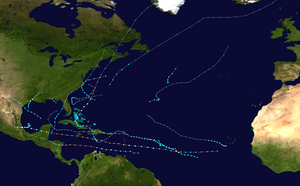Tropical Storm Erin (2007)
Tropical Storm Erin was the second tropical cyclone to make landfall in the United States in the 2007 Atlantic hurricane season. The fifth named storm of the season, it formed in the Gulf of Mexico on August 14 from a persistent area of convection. It attained tropical storm status the next day, and on August 16, 2007 Erin made landfall near Lamar, Texas, and persisted over land across Texas before moving northward into Oklahoma. Due to the brown ocean effect, Erin intensified after landfall.[1][2] The storm resulted in 16 fatalities and worsened an already-severe flooding issue in Texas.
| Tropical storm (SSHWS/NWS) | |
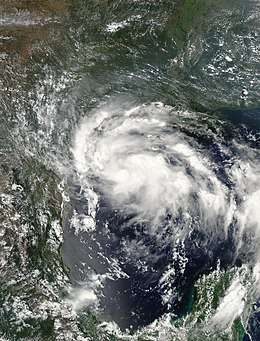 Tropical Storm Erin near landfall | |
| Formed | August 15, 2007 |
|---|---|
| Dissipated | August 20, 2007 |
| (Extratropical after August 17) | |
| Highest winds | 1-minute sustained: 40 mph (65 km/h) |
| Lowest pressure | 1003 mbar (hPa); 29.62 inHg |
| Fatalities | 21 direct |
| Damage | $248.3 million (2007 USD) |
| Areas affected | Texas, Oklahoma, central United States |
| Part of the 2007 Atlantic hurricane season | |
Meteorological history

On August 1, 2007, an area of convection developed just south of Jamaica in association with a trough of low pressure.[3] The system tracked west-northwestward, and by August 10 consisted of a broad surface trough with minimal shower activity.[4] Convection increased on August 11,[5] and by August 12 the interaction between a tropical wave and an upper-level low in the area resulted in a large area of disorganized thunderstorms extending from the western Caribbean Sea into the central Bahamas.[6] Upper-level winds gradually became more beneficial for development, and on August 13 a broad low pressure area formed about 90 miles (145 km) north-northeast of Cancún, Quintana Roo, Mexico.[7] Late on August 14, a Hurricane Hunters flight into the system reported a small circulation center, but at the time was not well-defined enough to result in the initiation of tropical cyclone advisories. However, deep convection was maintained near the increasingly organizing center, and at 0300 UTC on August 15 the National Hurricane Center classified it as Tropical Depression Five about 425 miles (685 km) southeast of Brownsville, Texas.[8]
In the overnight hours after formation, the storm was disorganized with a ragged and ill-defined center of circulation. Located to the south of a mid to upper-level ridge over the southern United States, the system tracked to the west-northwest through an environment conducive for further strengthening; an upper-level anticyclone developed over the central Gulf of Mexico, and sea surface temperatures along its track were warm.[9] The cloud pattern became better organized, maintaining a large area of convection with curved rainbands and well-established outflow.[10] Based on reports from Hurricane Hunters, the National Hurricane Center upgraded the depression to Tropical Storm Erin at 1530 UTC on August 15 about 250 miles (400 km) east of Brownsville, Texas.[11] As it continued northwestward, Erin remained disorganized and failed to strengthen beyond minimal tropical storm status.[12] At 1200 UTC on August 16 the cyclone made landfall near Lamar, Texas as it weakened to tropical depression status.[13] Three hours later, the National Hurricane Center ceased issuing advisories on Erin as warning responsibility was transferred to the Hydrometeorological Prediction Center.[14]
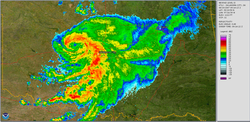
Drifting northwestward through Texas, Tropical Depression Erin maintained an area of convection near the center, with its widespread but scattered rainbands dropping moderate to heavy precipitation. By August 17, the winds decreased to 20 mph (30 km/h),[15] with higher gusts. The system turned to the north-northeast on August 18, while heavy bands of thunderstorms continued to rotate around the center of Erin.[16] Early on August 19 after entering Oklahoma, the remnants of Erin suddenly re-intensified to maximum sustained winds of 60 mph (95 km/h) a short distance west of Oklahoma City.[17][18] The Norman, Oklahoma National Weather Service remarked the intensification "[resulted] in what amounts to an inland tropical storm;"[19] at 0930 UTC the system presented an eye-like feature and a spiral rainband, and produced wind gusts of over 80 mph (130 km/h).[20] However, a few hours later, the depression began weakening again,[21] and late on August 19 Erin weakened significantly as the circulation dissipated over northeastern Oklahoma. Despite displaying tropical characteristics, the National Hurricane Center determined the system was not a tropical cyclone over Oklahoma, and classified it as a "low".[22] The low continued into southeastern Kansas before dissipating, feeding moisture northward toward a frontal system extending from the Midwestern United States through the Mid-Atlantic States.[23] Its remnant mid-level circulation then moved eastward across Missouri, Kentucky, and Virginia before losing identity as it moved out into the Atlantic Ocean.
Preparations
| Weather alerts as Tropical Storm Erin made landfall in Texas | |||
|---|---|---|---|
Weather alerts as Tropical Storm Erin makes landfall in Texas | |||
| Tornado Warning | Flash Flood Warning | ||
| Inland Tropical Storm Warning | Tropical Storm Warning | ||
| Flood Warning | Flash Flood Watch | ||
| Small Craft Advisory | |||
Immediately upon becoming a tropical cyclone, the National Hurricane Center issued a tropical storm watch from Freeport, Texas to the United States/Mexico border; at the same time, the government of Mexico issued a tropical storm watch southward to Rio San Fernando.[24] Shortly before attaining tropical storm status, the watch in Texas was upgraded to a tropical storm warning.[25] Late on August 15, the warning was extended to San Luis Pass, while the watch in Mexico was discontinued.[26] As Erin made landfall, the warning was canceled,[13] and several flood watches and warnings were issued for counties across southeastern Texas.[27] Upon moving into Oklahoma, flood and flash flood warnings were issued for several counties.[21]
Governor Rick Perry activated the National Guard and mobilized emergency personnel to the region expected to be affected by the storm.[28] Erin was expected to bring flooding to the region, which had already been declared a disaster area on August 7, 2007 due to widespread flooding on the Nueces River basin;[29] this area remained flooded as of August 15, 2007.[30] On August 15, oil futures rose to $74.01 (USD), due to fears of Erin disrupting oil supplies produced on Texan coasts, combined with low oil inventories.[31] As a result of the threat from the storm, Shell Oil Company evacuated 188 workers on oil platforms in the northwestern Gulf of Mexico.[32]
Impact
Texas
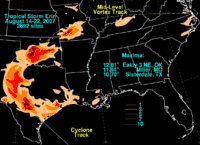
By midday on August 15, rainbands with gusty winds began affecting the Texas coastline.[11] As it moved ashore, the storm produced heavy rainfall near and to the or northeast of its path, reaching 11.02 inches (280 mm) at a station in Lockwood.[21] The storm caused several bayous in the Houston area to reach or exceed flood levels.[33] Across southeastern Texas, the cyclone spawned several funnel clouds,[34] and near IAH an EF0 tornado was reported. Wind gusts from Erin were minor across the state, peaking at 35 mph (55 km/h) at Palacios with an unofficial report of 39 mph (63 km/h) at Jamaica Beach. Upon moving ashore, the storm produced a minor storm surge peaking at 3.22 feet (0.98 m) at Pleasure Pier, which caused minor beach erosion.[35]
In Clear Lake City, heavy rainfall collapsed a portion of a grocery store roof, killing two workers. The precipitation caused moderate flooding across eastern portions of Harris County; over 400 homes and 40 businesses were flooded.[35] Flooding across the Greater Houston area briefly halted the METRORail and closed several state roads. One person drowned after driving into a retention pond.[36] Several people required rescue assistance,[33] and in Comal County a car accident caused three fatalities.[37] The passage of the storm temporarily left about 20,000 electrical customers without power, though most outages were quickly restored.[33] In San Antonio, one body was recovered from a creek and another died after driving into a flooded road and was swept into a drainage ditch in which four others survived. In Sisterdale, two people were killed when they were swept away stalled over Sister Creek.[38] In Taylor County, near Abilene, flooding killed one person and forced the evacuation of about 2,000 people.[39] Damage in Texas totaled over $45 million (2007 USD).[40][41][42]
Oklahoma
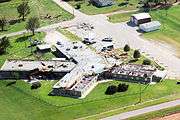
After its unexpected redevelopment over Oklahoma, widespread damage was also reported there. Several communities in central Oklahoma were flooded due to the heavy rainfall. Watonga, Kingfisher and Geary were the hardest-hit communities, where many houses and buildings were inundated. The weather forced the cancellation of the Hydro Fair as the carnival rides were not safe in heavy rain and high wind. Winds in Watonga gusted as high as 82 mph (131 km/h), which damaged numerous trees and power lines and heavily damaged mobile homes. The entire community lost power, as did about 15,000 customers in total in the Oklahoma City metropolitan area. A section of Interstate 40 was also closed for a while.[43]
One person drowned in a cellar in Fort Cobb, and another drowned in Kingfisher.[44] Another storm-related death took place in Seminole.[45] Three others were found dead after a weather-related automobile accident also near Carnegie.[46] Another automobile accident fatality took place in Okmulgee County but it is unclear if the event was storm-related.[47] Damage amounted to over $2 million (2007 USD).[48][49]
Missouri
Although its surface circulation had dissipated, its circulation aloft remained intact and led to a burst of rainfall early on August 20. The 11.94 inches/303.3 mm that fell at Miller[17] became the wettest Missouri rainfall total associated with a tropical cyclone, or its remains, since at least 1972.[50] One person died in Sleeper when he drove into flood waters which had swept away a bridge he was attempting to navigate onto.[51] Nine water rescues occurred along the I-44 corridor, mostly caused by Erin's rainfall.[52] Damage totaled about $19.8 million (2007 USD) in the state, primarily in Polk County.[53][54][55][56][57]
See also
- 2007 Midwest flooding
- Derecho
- Other storms of the same name
- Timeline of the 2007 Atlantic hurricane season
- Tropical Storm Bill (2015) - another storm that took the same general path, and was affected by the Brown ocean effect.
- Tropical Storm Imelda - yet another storm in 2019 that took the same general path and devastated Texas with severe flooding.
References
- Clark Evans, Russ S. Schumacher, and Thomas J. Galarneau Jr. (2011). "Sensitivity in the Overland Reintensification of Tropical Cyclone Erin (2007) to Near-Surface Soil Moisture Characteristics". Monthly Weather Review. 139 (12): 3848. Bibcode:2011MWRv..139.3848E. doi:10.1175/2011MWR3593.1.CS1 maint: uses authors parameter (link)
- Jeff Masters and Bob Henson (15 June 2015). "Dangerous Flood Potential in Texas, Oklahoma from Invest 91L". Archived from the original on 15 June 2015. Retrieved 15 June 2015.CS1 maint: uses authors parameter (link)
- Beven (2007). "August 9 Tropical Weather Outlook". National Hurricane Center. Retrieved 2007-08-14.
- Beven (2007). "August 10 Tropical Weather Outlook". National Hurricane Center. Retrieved 2007-08-14.
- Rhome (2007). "August 11 Tropical Weather Outlook". National Hurricane Center. Retrieved 2007-08-14.
- Blake (2007). "August 12 Tropical Weather Outlook". National Hurricane Center. Retrieved 2007-08-14.
- Knabb/Blake (2007). "August 13 Tropical Weather Outlook". National Hurricane Center. Retrieved 2007-08-14.
- Franklin (2007). "Tropical Depression Five Discussion One". National Hurricane Center. Retrieved 2007-08-14.
- Rhome (2007). "Tropical Depression Five Discussion Two". National Hurricane Center. Retrieved 2007-08-15.
- Avila (2007). "Tropical Depression Five Discussion Three". National Hurricane Center. Retrieved 2007-08-15.
- Avila (2007). "Tropical Storm Erin Special Advisory 4". National Hurricane Center. Retrieved 2007-08-15.
- Rhome/Beven (2007). "Tropical Storm Erin Discussion Six". National Hurricane Center. Retrieved 2007-08-16.
- Avila (2007). "Tropical Storm Erin Intermediate Advisory 7a". National Hurricane Center. Retrieved 2007-08-16.
- Avila (2007). "Tropical Depression Erin Discussion Eight". National Hurricane Center. Retrieved 2007-08-16.
- Kocin (2007). "Tropical Depression Erin Public Advisory Thirteen". Archived from the original on January 16, 2008. Retrieved 2007-08-19.
- Kocin (2007). "Tropical Depression Erin Public Advisory Fourteen". Archived from the original on January 16, 2008. Retrieved 2007-08-19.
- David M. Roth (2007). "Tropical Storm Erin Rainfall". Hydrometeorological Prediction Center. Retrieved 2007-08-24.
- Krikken and Steeneveld (2012). "Modelling the re-intensification of tropical storm Erin (2007) over Oklahoma: understanding the key role of downdraft formulation". Retrieved 2015-03-08.
- Norman, Oklahoma National Weather (2007). "August 19 Short Term Forecast". Retrieved 2019-07-26.
- Norman, Oklahoma National Weather Service (2007). "An Unusual Tropical System..." Archived from the original on April 13, 2008. Retrieved 2007-08-19.
- Otto (2007). "Tropical Depression Erin Public Advisory Twenty". Hydrometeorological Prediction Center. Archived from the original on January 16, 2008. Retrieved 2007-08-19.
- Richard D. Knabb (2007). "Tropical Storm Erin Tropical Cyclone Report" (PDF). National Hurricane Center. Retrieved 2008-08-11.
- Kocin (2007). "Remnants of Erin Public Advisory Twenty-Two". Hydrometeorological Prediction Center. Retrieved 2007-08-19.
- Franklin (2007). "Tropical Depression Five Public Advisory One". National Hurricane Center. Retrieved 2007-08-14.
- Avila (2007). "Tropical Depression Five Public Advisory Three". National Hurricane Center. Retrieved 2007-08-15.
- Avila (2007). "Tropical Storm Erin Public Advisory Five". National Hurricane Center. Retrieved 2007-08-15.
- Kocin (2007). "Public Advisory Number 9 for Tropical Depression Erin". Hydrometeorological Prediction Center. Retrieved 2007-08-16.
- NBC News News Services (2007-08-15). "Tropical Storm Erin forms, heads for Texas". NBC News. Retrieved 2007-08-15.
- Beth Wilson (2007-08-07). "Nueces declared disaster area from river flooding". Corpus Christi Caller-Times. Retrieved 2007-08-15.
- National Weather Service (2007-08-15). "Advanced Hydrologic Prediction Service: Corpus Christi: Nueces River near Bluntzer". National Oceanic and Atmospheric Administration. Archived from the original on 2009-04-25. Retrieved 2007-08-15.
- Steve Hargreaves (2007-08-15). "Oil gains on inventories, storms". CNN. Retrieved 2007-08-15.
- John Porretto (2007). "Remnants of storm Erin deluge Houston". Associated Press. Retrieved 2007-08-16.
- Rad Sallee & Eric Berger (2007). "Erin hits Texas coast, sparks flash flood warnings". Houston Chronicle. Retrieved 2007-08-16.
- Morales; et al. (2007). "Tropical Storm Erin Post-Tropical Cyclone Report". Corpus Christi, Texas National Weather Service. Retrieved 2007-08-23.
- Hafele & Blood (2007). "Post-Tropical Cyclone Report on Erin". Houston/Galveston National Weather Service. Retrieved 2007-08-23.
- United Press International (2007). "Tropical Storm Erin leaves 7 dead in Texas". Archived from the original on 2007-08-19. Retrieved 2007-08-23.
- Bruce Nichols (2007). "At least four dead as Erin floods Texas". Reuters. Archived from the original on 2007-08-30. Retrieved 2007-08-16.
- "At least 10 die in Texas in latest floods - UPI.com". Archived from the original on 2007-08-21. Retrieved 2007-08-21.
- weatherplus.com - Weather News - Eighth Body Found After Texas Flooding
- National Climatic Data Center (2008). "Event Report for Texas". Archived from the original on 2011-05-20. Retrieved 2008-03-24.
- National Climatic Data Center (2008). "Event Report for Texas (2)". Archived from the original on 2011-05-20. Retrieved 2008-03-24.
- National Climatic Data Center (2008). "Event Report for Texas (3)". Archived from the original on 2011-05-20. Retrieved 2008-03-24.
- "6 Dead After Tropical Storm Moves Through State". KOCO Oklahoma City. 2007.
- Staff Writer (2007). "Heavy rains cause flooding, evacuations, two deaths and possibly three more". The Oklahoman. Retrieved 2008-08-11.
- Staff Writer (2007). "Eye turned toward recovery". The Oklahoman. Retrieved 2008-08-11.
- Ron Jackson (2007-08-19). "Official's wife, daughter die in flooding". NewsOK. Retrieved 2007-08-21.
- Johnny Johnson (2007-08-19). "Accident claims 1". NewsOK. Retrieved 2007-08-21.
- National Climatic Data Center (2008). "Event Report for Oklahoma". Archived from the original on 2011-05-20. Retrieved 2008-03-24.
- National Climatic Data Center (2008). "Event Report for Oklahoma (2)". Archived from the original on 2011-05-20. Retrieved 2008-03-24.
- Roth, David M; Weather Prediction Center (January 7, 2013). "Maximum Rainfall caused by Tropical Cyclones and their Remnants Per State (1950–2012)". Tropical Cyclone Point Maxima. United States National Oceanic and Atmospheric Administration's National Weather Service. Retrieved March 15, 2013.
- National Weather Service Office Springfield, Missouri. Preliminary local storm report...summary. Retrieved on 2007-08-30.
- Federal Emergency Management Agency. National Situation Update: Wednesday, August 22, 2007. Archived July 3, 2012, at the Wayback Machine Retrieved on 2007-08-30.
- National Climatic Data Center (2008). "Event Report for Missouri". Archived from the original on 2011-05-20. Retrieved 2008-03-24.
- National Climatic Data Center (2008). "Event Report for Missouri (2)". Archived from the original on 2011-05-20. Retrieved 2008-03-24.
- National Climatic Data Center (2008). "Event Report for Missouri (3)". Archived from the original on 2011-05-20. Retrieved 2008-03-24.
- National Climatic Data Center (2008). "Event Report for Missouri (4)". Archived from the original on 2011-05-20. Retrieved 2008-03-24.
- National Climatic Data Center (2008). "Event Report for Missouri (5)". Archived from the original on 2011-05-20. Retrieved 2008-03-24.
External links
| Wikimedia Commons has media related to Tropical Storm Erin (2007). |
- See the NHC advisory archive on Tropical Storm Erin
- See the HPC advisory archive on Tropical Depression Erin
